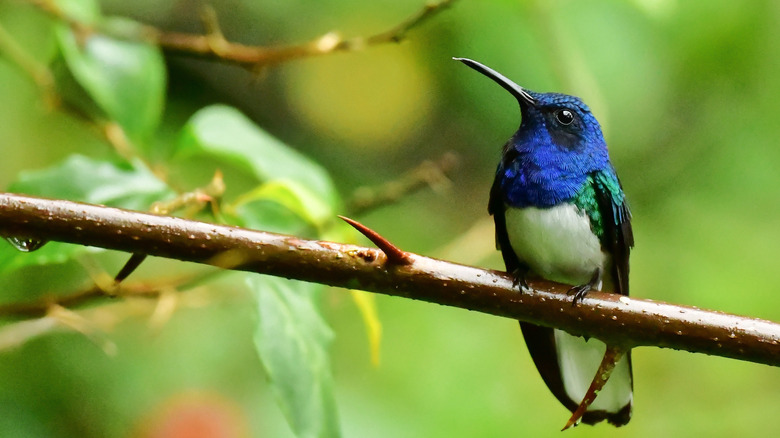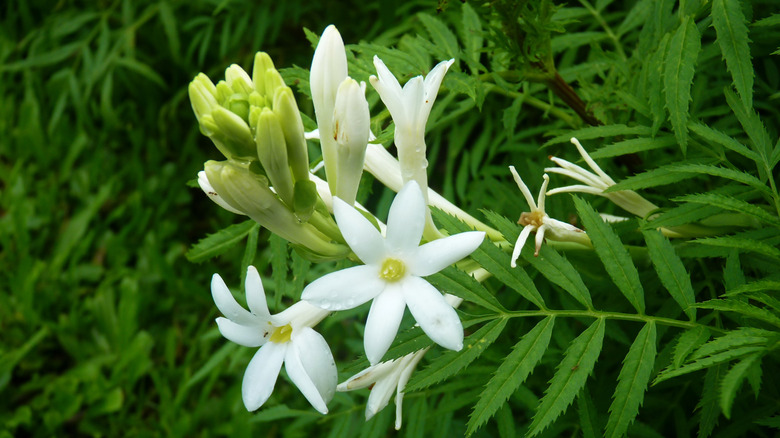The Long-Blooming Flower You Should Grow For Hummingbirds (& An Amazing-Smelling Garden)
Hummingbirds, because of their high-energy metabolism, are constantly searching for reliable sources of food. When they can't find flowers, the tiny birds scoop insects out of the air and even help themselves to the sugary sap woodpeckers uncover on trees. However, you can plant certain flowers to attract the birds to your home. A garden filled with sweet-smelling flowers satisfies our senses, and the high sugar content nectar produced by the blooms satisfies the busy bird's need for sustenance. The waxy white flowers of tuberose (Agave amica), hardy in USDA zones 8 through 10, form a 2.5-inch-long tube with six flared tepals (petal-like structures) at the top. Their fragrance is described as both "musky, spicy and floral" (via Charlotte.edu). As a bonus, this hummingbird nectar could attract other garden friends.
Popular history tells us that young women in the Victorian era were forbidden to enter gardens with tuberose for fear the scent was so seductive they'd lose their inhibitions. Marie Antoinette was so enamored of the aroma that it was included in a perfume made especially for her called Parfum de Trianon. An entire house can be perfumed by the extremely intense odor of a single tuberose stem, but the distinctive flowers fell out of favor for a while after the smell became associated with funerals. The long stems, graceful flowers, and powerful aroma of tuberose make it a striking addition to a hummingbird garden. In the evening, tuberose fragrance intensifies, making this night bloomer an apt candidate for a moon garden, a contemplative space filled with flowers, trees, and objects that reflect the moonlight.
Growing tuberose in your garden
Formerly classified as Polianthes tuberosa, Agave amica is a herbaceous perennial that produces 3-foot-tall stems topped with flowers growing from an 18-inch-tall base of strap-like green leaves. As the name suggests, tuberose grow from tubers that resemble bulbs. They should be planted 2 inches deep and about 8 inches apart in well-drained and occasionally dry sandy or loamy soil. The plants prefer full or partial sun and a neutral soil pH. Water them regularly during the growing season, but avoid overwatering as this causes root rot. Taper watering off after the leaves start to yellow. Flowers begin to appear in the summer and continue to bloom through September. Learn how to spot aphid and spider mite damage on the plants, as this is a problem you can run into. Scale insects, anthracnose, and thrips are other common tuberose pests.
If you live in the cooler ranges of the tuberose hardiness zones, your plants might survive the winter if they're heavily mulched after they've died back. If you'd rather not take the chance, dig up the tubers, remove the old stalk, and store them in slightly moist peat moss in a dark area where there's no chance of freezing. Replant them in the spring. Even if you live in a warm area, tuberose needs to be dug up and divided every four or five years to promote robust flowering.
Tuberose is a cultigen, meaning it has been cultivated for so long that it no longer appears naturally in the wild. Aztecs are believed to be the first to cultivate it for use as a cut flower. The Spanish introduced it to Europe, and from there, it quickly became a favorite for its fragrant, long-lasting blooms.

